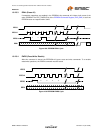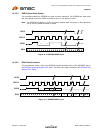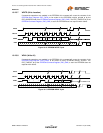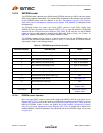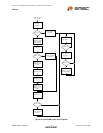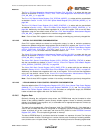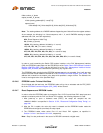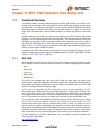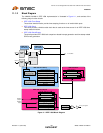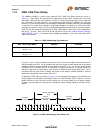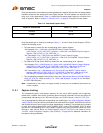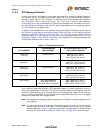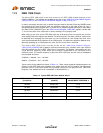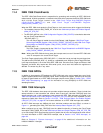
Two Port 10/100 Managed Ethernet Switch with 16-Bit Non-PCI CPU Interface
Datasheet
SMSC LAN9311/LAN9311i 155 Revision 1.4 (08-19-08)
DATASHEET
Chapter 11 IEEE 1588 Hardware Time Stamp Unit
11.1 Functional Overview
The LAN9311/LAN9311i provides hardware support for the IEEE 1588 Precision Time Protocol (PTP),
allowing clock synchronization with remote Ethernet devices, packet time stamping, and time driven
event generation. Time stamping is supported on all ports, with an individual IEEE 1588 Time Stamp
module connected to each port via the MII bus. Any port may function as a master or a slave clock
per the IEEE 1588 specification, and the LAN9311/LAN9311i as a whole may function as a boundary
clock.
A 64-bit tunable clock is provided that is used as the time source for all IEEE 1588 time stamp related
functions. An IEEE 1588 Clock/Events block provides IEEE 1588 clock comparison based interrupt
generation and time stamp related GPIO event generation. Two LAN9311/LAN9311i GPIO pins
(GPIO[8:9]) can be used to trigger a time stamp capture when configured as an input, or output a
signal from the GPIO based on an IEEE 1588 clock target compare event when configured as an
output. Section 11.1.2, "Block Diagram" describes the various IEEE 1588 related blocks and how they
interface to other LAN9311/LAN9311i functions.
All features of the IEEE 1588 hardware time stamp unit can be monitored and configured via their
respective configuration and status registers. A detailed description of all IEEE 1588 CSRs is included
in Section 14.2.5, "IEEE 1588," on page 202.
11.1.1 IEEE 1588
IEEE 1588 specifies a Precision Time Protocol (PTP) used by master and slave clock devices to pass
time information in order to achieve clock synchronization. Five network message types are defined:
Sync
Delay_Req
Follow_Up
Delay_Resp
Management
Only the first four message types (Sync, Delay_Req, Follow_Up, Delay_Resp) are used for clock
synchronization. Using these messages, the protocol software may calculate the offset and network
delay between time stamps, adjusting the slave clock frequency as needed. Refer to the IEEE 1588
protocol for message definitions and proper usage.
A PTP domain is segmented into PTP sub-domains, which are then segmented into PTP
communication paths. Within each PTP communication path there is a maximum of one master clock,
which is the source of time for each slave clock. The determination of which clock is the master and
which clock(s) is(are) the slave(s) is not fixed, but determined by the IEEE 1588 protocol. Similarly,
each PTP sub-domain may have only one master clock, referred to as the Grand Master Clock.
PTP communication paths are conceptually equivalent to Ethernet collision domains and may contain
devices which extend the network. However, unlike Ethernet collision domains, the PTP
communication path does not stop at a network switch, bridge, or router. This leads to a loss of
precision when the network switch/bridge/router introduces a variable delay. Boundary clocks are
defined which conceptually bypass the switch/bridge/router (either physically or via device integration).
Essentially, a boundary clock acts as a slave to an upstream master, and as a master to a down stream
slave. A boundary clock may contain multiple ports, but a maximum of one slave port is permitted.
For more information on the IEEE 1588 protocol, refer to the National Institute of Standards and
Technology IEEE 1588 website:
http://ieee1588.nist.gov/



